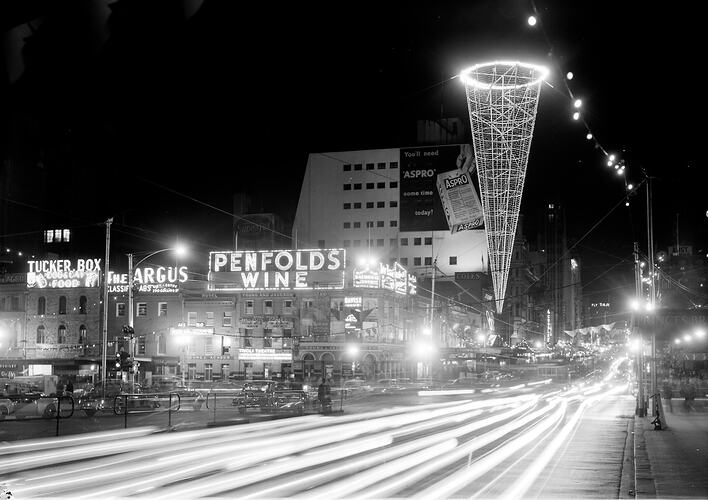Summary
The corner of Flinders and Swanston Streets, Melbourne, featuring various buildings including Young and Jackson Hotel and a number of shops and offices. The streets have been decorated with lights and flags and a large illuminated torch to commemorate the Olympic Games held in Melbourne in 1956. The photograph has been taken with a long exposure, making a particular feature out of the lighting on the tram tracks.
This image is part of the Laurie Richards Collection at Museum Victoria comprising approximately 85,000 negatives taken by the Melbourne based Laurie Richards Studio between the 1950s -1970s. These negatives are all mostly large format [5"x 4"/ 12.5 x 10 cm], black and white images, though a significant number are in colour. The many photographic jobs that were undertaken in the course of thirty years are itemised in a set of log books, copies of which are also held by Museum Victoria.
Description of Content
A night view of the corner of Flinders and Swanston Streets, Melbourne. A large model of the Olympic torch is lit up on a building on Swanston Street, just north of the corner of Flinders Street. Young and Jackson Hotel and a number of shops and offices nearby have neon signage advertising products such as Penfolds wine, The Argus newspaper, and Tucker Box dog and cat food. The photograph has been taken with a long exposure, making a feature out of the lighting on the tram tracks. On the tram tracks there are bright white tubes of light snaking along Swanston Street. The cars moving through the intersection have 'ghosted'. A solitary person stands at the tram stop on the south side of Swanston Street.
Physical Description
Black and white negative.
Significance
Because of the breadth of both the subject matter photographed and the diverse businesses which commissioned the work, and the excellent documentation that accompanies the collection, the Laurie Richards Collection at Museum Victoria is an invaluable record of Melbourne's commercial and industrial past and as such gives an insight into the social history of that period.
More Information
-
Collection Names
Laurie Richards Collection, 1956 Melbourne Olympic Games Collection
-
Collecting Areas
-
Acquisition Information
Purchase
-
Place & Date Depicted
Swanston Street, Melbourne, Greater Melbourne, Victoria, Australia, 1956
-
Photographer
Laurie Richards Studio, 4 Tower Avenue, Alphington, Greater Melbourne, Victoria, Australia, 1956
-
Format
Negative, 5" x 4", Black & White
-
Classification
-
Category
-
Discipline
-
Type of item
-
Image Dimensions - Negative/s
103 mm (Width), 100 mm (Height)
Approximate Dimensions
-
Keywords
Billboards, Decorations, Hotels, Lighting, Motor Cars, Offices, Olympic Games: Melbourne, 1956, Shops, Theatres


